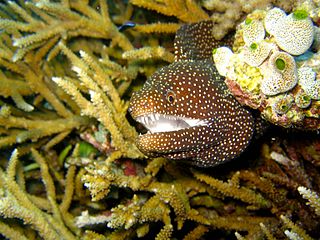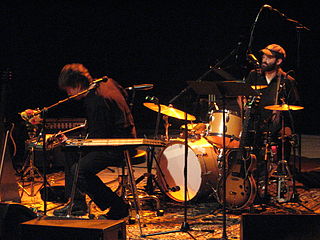
The European eel is a species of eel. Their life history was a mystery for thousands of years, and mating in the wild has not yet been observed. The five stages of their development were originally thought to be different species. They are critically endangered due to hydroelectric dams, overfishing by fisheries on coasts for human consumption, and parasites.

Moray eels, or Muraenidae, are a family of eels whose members are found worldwide. There are approximately 200 species in 15 genera which are almost exclusively marine, but several species are regularly seen in brackish water, and a few are found in fresh water.

Eels is an American rock band formed in Los Angeles in 1991 by singer-songwriter and multi-instrumentalist Mark Oliver Everett, known by the stage name E. Band members have changed over the years, both in the studio and on stage, making Everett the only official member for most of the band's work. Eels' music is often filled with themes of family, death, and unrequited love. Since 1996, Eels has released fifteen studio albums, seven of which entered the Billboard 200.

The Parramatta Eels are an Australian professional rugby league football club based in the Sydney suburb of Parramatta that competes in the National Rugby League (NRL).

Nettastomatidae, the duckbill eels or witch eels are a family of eels. The name is from νῆττα and στόμα.
The Eel is an alias used by two fictional characters appearing in American comic books published by Marvel Comics. The first character to take up the identity was Leopold Stryke who first appeared in Strange Tales #112 created by Stan Lee and Dick Ayers, while his successor, Edward Lavell, first appeared in Power Man and Iron Fist #92. Both Eels were at one point members of the Serpent Squad even though the character they portray was not actually based on a snake, but on a fish that resembled a snake. Neither Eel has ever been featured as a regular character in any of Marvel's ongoing or limited series.

Leptocephalus is a genus that was used for species of larval eels, called leptocephali. Leptocephali larvae differ so much in appearance from their adults. When first discovered, leptocephali were thought to be a distinct type of fish, not an eel specie. Because of this, the genus designation of Leptocephalus was used for a while for an unidentified leptocephali. After it was known that these were eel larvae, it was identified to be part of a wastebasket taxon, but not anymore in the present classification system. Examples of marine congrid larvae, found in the western Indian Ocean and the Red Sea that were named this way are listed below. Only two species in two families are currently treated as having any validity, though the validity of L. bellottii is strongly in doubt.

Eels are ray-finned fish belonging to the order Anguilliformes, which consists of eight suborders, 20 families, 164 genera, and about 1000 species. Eels undergo considerable development from the early larval stage to the eventual adult stage and are usually predators.

Nettastoma is a genus of eels in the duckbill eel family Nettastomatidae.
Saurenchelys is a genus of eels in the duckbill eel family Nettastomatidae.

Eels are elongated fish, ranging in length from five centimetres (2 in) to four metres (13 ft). Adults range in weight from 30 grams to over 25 kilograms. They possess no pelvic fins, and many species also lack pectoral fins. The dorsal and anal fins are fused with the caudal or tail fin, forming a single ribbon running along much of the length of the animal. Most eels live in the shallow waters of the ocean and burrow into sand, mud, or amongst rocks. A majority of eel species are nocturnal and thus are rarely seen. Sometimes, they are seen living together in holes, or "eel pits". Some species of eels live in deeper water on the continental shelves and over the slopes deep as 4,000 metres (13,000 ft). Only members of the family Anguillidae regularly inhabit fresh water, but they too return to the sea to breed.
The slender sorcerer is an eel in the family Nettastomatidae. It was described by Wilhelm Peters in 1864. It is a marine, tropical eel which is known from the eastern Atlantic and Indian Ocean, including the River Congo and the Mediterranean. It dwells at a depth range of 185 to 700 metres. Males can reach a maximum total length of 65 centimetres (26 in).
The longface eel is an eel in the family Nettastomatidae. It was described by David G. Smith in 1989. It is a marine, tropical eel which is known from the western central Atlantic Ocean, including North Carolina and Florida, USA, the northwestern Gulf of Mexico, and Mobile Bay. It dwells at a depth range of 59 to 158 meters. Males can reach a maximum total length of 36 centimeters (14 in).
The blacktail buckbill eel, also known commonly as the blacktail duckbill, or the duckbill eel in Malaysia, is an eel in the family Nettastomatidae. It was described by David Starr Jordan and John Otterbein Snyder in 1901, originally under the genus Chlopsis. It is a marine, tropical eel which is known from the western Pacific Ocean, including Japan, China, Malaysia, the Philippines, and Taiwan. It is known to dwell at a depth range of 100 to 500 meters. Males can reach a maximum total length of 50 centimeters (20 in).
Saurenchelys lateromaculata is a species of eel in the family Nettastomatidae. It was described by Umberto D'Ancona in 1928, originally under the genus Leptocephalus. It is a marine, tropical eel which is known from the Indo-Western Pacific, including the South China Sea and possibly also the Red Sea.
Saurenchelys meteori is an eel in the family Nettastomatidae. It was described by Wolfgang Klausewitz and Uwe Zajonz in 2000. It is a marine, deep water-dwelling eel which is known from the western Indian Ocean, including Djibouti, Eritrea, Egypt, Saudi Arabia, Sudan, Yemen and Somalia. It is known to dwell at a depth range of 696 to 705 metres. Males can reach a maximum total length of 44.2 centimetres (17.4 in).
The pillar wire eel is an eel in the family Nettastomatidae. It was described by Einar Hagbart Martin Lea in 1913, originally under the genus Leptocephalus. It is a marine, tropical eel which is known from the western Pacific Ocean. It is oceanodromous, and is known to dwell at a depth range of 27 to 460 metres.
Saurenchelys taiwanensis is an eel in the family Nettastomatidae. It was described by Emma Stanislavovna Karmovskaya in 2004. It is a marine, deep water-dwelling eel which is known from the Philippines, in the western Pacific Ocean. It is known to dwell at a depth range of 1,043 to 1,102 metres. Males can reach a maximum total length of 34.2 centimetres (13.5 in).

The electric eels are a genus, Electrophorus, of neotropical freshwater fish from South America in the family Gymnotidae. They are known for their ability to stun their prey by generating electricity, delivering shocks at up to 860 volts. Their electrical capabilities were first studied in 1775, contributing to the invention in 1800 of the electric battery.









